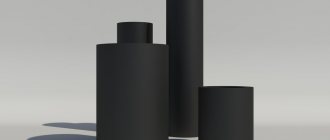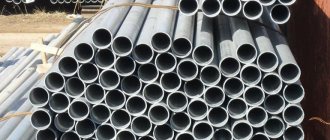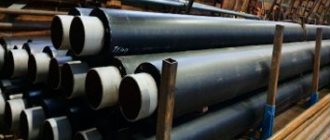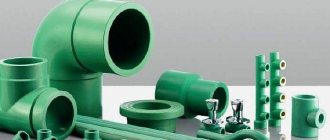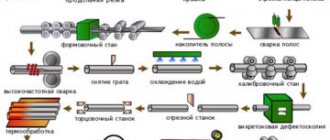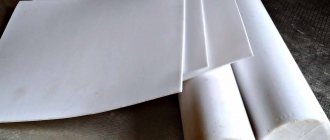The VGP pipe, the abbreviation in the name of which stands for “water and gas pipeline,” is specially designed for laying water and gas communications. Even in our time, when modern manufacturers offer a huge range of pipes made from various materials, such specialized steel pipe products are extremely popular among construction and repair organizations, and enterprises working in the housing and communal services sector.
Pipes VGP GOST 3262-75
You can familiarize yourself with all GOST requirements for steel VGP pipes by downloading this document in pdf format from the link below.
GOST 3262-75 Steel water and gas pipes. Specifications
The relevance of using pipes of this category
The high popularity enjoyed by VGP pipes made from steel alloys can be explained very simply. No matter how exceptional the characteristics of today's popular pipes made of polymeric materials may be, their use in many cases is simply not possible. Such cases, in particular, include installation of a pipeline in the open air, where it will be affected by a lot of negative factors.
The demand for such products is also explained by the fact that, according to generally accepted requirements, pipelines for transporting gas and supplying it to consumers can only be made of steel pipes. That is why VGP pipes are simply an irreplaceable material in any gas industry.
Gas supply to a private home is a typical example of using VGP pipes
Features and Specifications
Steel water pipelines have the following characteristics. Some positive aspects have already been partially discussed above, but not everything is so rosy with this pipe rolling range.
It also has negative characteristics:
- Corrosive formations. Unfortunately, steel is susceptible to this effect. And the water supply system feels this with particular acuteness. In it, moisture is constantly combined with atmospheric oxygen. Such a combination is simply destructive for steel.
- Decrease in lumen over time. Such a highway tends to become overgrown over time. Her clearance can catastrophically decrease in just a couple of years.
- Labor-intensive installation and dismantling. Speaking about a steel pipeline, we must immediately make a reservation that assembling it is more difficult than tightening several nuts on fittings of a metal-plastic structure, or welding polypropylene pieces with a small welder. Connecting a steel water pipe will require the participation of a professional welder.
- Impressive weight. This characteristic feature of steel water supply pipe materials greatly complicates transportation and installation.
IMPORTANT! Steel networks can be protected from such a significant drawback as corrosion by priming and painting.
How pipes are made
The main material from which pipes belonging to the VGP category are produced is carbon steel. The technological process of their production consists of the following stages:
- first, steel blanks are prepared - strips, which are long metal strips with the required thickness and width parameters;
- then a pipe is formed from the prepared strip, for which special equipment is used;
- the joint formed on the resulting product is welded using electric welding.
Stages of production of water and gas pipes
The qualitative characteristics that pipes of the VGP category manufactured using this technology must meet are stipulated by the provisions of GOST 3262-75.
Taking into account the fact that pipes of this category are operated in rather difficult conditions, and very high demands are placed on the quality of the weld being created, the place of the formed joint must be checked using radiographic control methods.
The main influence on the service life of pipelines made from water and gas pipe products is their operating conditions, as well as the characteristics of the substance that is transported through them. This is explained by the fact that the transported substances have different chemical reactivity.
Briefly about VGP
All that remains is to clarify the very concept of a VGP pipe: what it is, and how the product differs from other steel pipes. In principle, a water and gas pipe is a special case, one of the widely used varieties, of electric-welded metal, produced in accordance with GOST 3262 standards. Its main difference from its “brothers” is the reinforced seam, a feature that allows it to withstand greater pressure than other materials. In addition, the VGP pipe is distinguished by increased anti-corrosion qualities, which is also an important factor in the technical operating conditions.
What to look for when choosing pipes
For the end user, who needs such steel pipes to solve specific problems, certain operational characteristics of these products are of interest, allowing them to be selected optimally.
In order to make the right choice of such pipes and use them in accordance with their main purpose, it is important to understand the classification of products. The criteria by which such classification is carried out are stipulated by the provisions of GOST 3262-75.
Important criteria for sorting pipes of the VGP category are the material and method of their manufacture, as well as the method of their processing. So, depending on these parameters, pipes are distinguished:
- made of ferrous metal, the surface of which is not protected in any way;
- pipes whose surface is galvanized.
VGP galvanized pipe DN 57x3.5
Tubular products, on the inner and outer surface of which a thin layer of zinc is applied, even differ in appearance from ordinary ones, as can be seen by comparing their photos. Such surface treatment of pipe products is necessary in order to reliably protect them from the aggressive influence of the external environment. Pipes coated with a thin layer of zinc, due to the chemical properties of this metal, perfectly resist corrosion and can be successfully operated even in the most difficult conditions for a long period of time.
Important parameters of such pipes, regardless of whether they are galvanized or not, are their geometric dimensions: nominal diameter, which is denoted by the abbreviation DU, as well as their wall thickness.
Significant geometric parameters of VGP pipes
All geometric parameters of pipes of the VGP category, including their diameter, must comply with the requirements specified in GOST. All geometric dimensions of pipes produced by modern industry can be selected using the appropriate tables.
Range of produced VGP pipes by size and weight
From the production line, water and gas pipe products can be produced in two modifications:
- without thread;
- with ready-made threads on both ends, which are applied by rolling or cutting.
Decoding the numbers in the designation allows you to find out the exact diameter of the product. Thus, products for which their DU is designated by the number 50 (VGP pipe DU50) have a diameter equal to two inches. And for pipes of the VGP category, the designation of which includes DU25, the diameter is equal to one inch. Accordingly, the markings of water and gas pipes indicate their diameter in millimeters, and converting it into inches is not difficult.
The documentation accompanying the product contains the necessary information
Application area
VGP products are able to withstand strong hydraulic shocks, as well as thermal deformation of the transported liquid. For domestic purposes they are intended for transportation:
- water (cold and hot);
- low pressure gas.
For water supply, VGP pipes are connected by welding, as well as using threaded connections and other additional parts.
The products have found application in the creation of various metal structures: fences, small architectural forms, scaffolding, cabinets, weights, whatnots. Most of the products are used in the housing and public utilities sector. Almost all apartments and houses use such material to provide them with water, heat and domestic gas. Modern manufacturing companies have the appropriate certificates. This suggests that manufacturers adhere to the standards in a particular GOST.
There is also a hygiene certificate. It is obtained after passing a sanitary and epidemiological examination. Certificates apply to the entire range of products.
Classification of pipes according to their accuracy class
Water and gas pipes are divided into two main categories according to their accuracy classes. The first category includes tubular products of ordinary precision. When producing products of this category, the following parameters are not standardized: the chemical composition of the manufacturing material, its mechanical characteristics. Pipes of this category are quite successfully used for arranging gas and water communications for domestic purposes.
The second category includes water and gas pipe products of increased precision. Galvanized pipes also belong to this category. From such pipes, for which both the chemical composition of the manufacturing material and its mechanical characteristics are standardized, parts for industrial pipelines are made with increased requirements for their reliability.
Requirements for high-precision pipes
Main advantages
VGP pipes are in demand for the construction of main lines and domestic pipelines. They use gas or water as a working medium. The main advantages of such products are the following indicators:
- low coefficient of linear expansion, which prevents deformation of the structure under the influence of high and very low temperatures;
- high strength compared to polypropylene and many other materials;
- possibility of use in pressure-type structures;
- good thermal conductivity, which has a positive effect on maintaining the temperature of the transported working environment;
- tightness allows the delivery of volatile and gaseous substances, acids and many other chemically active substances through pipes.
A high thermal conductivity coefficient can lead to cooling of the transported working medium. To avoid this, VGP pipes are used with additional thermal insulation materials.
Extra options
For the convenience of those who are going to purchase water and gas pipes and use them for certain purposes, the length of such products is also standardized and may correspond to one of the following categories:
- interval 4–12 meters - measured length;
- length of pipes, a multiple of their measured value;
- unmeasured length, which, nevertheless, must be within the limits of the measured value.
Consumers of such products should keep in mind that the price is set not per unit of pipe length, but per unit of its weight. It is also important to take into account that the weight of galvanized pipes is 3% higher than the weight of products made from unprotected steel.
Steels from which high-precision galvanized and non-galvanized pipe products are produced must comply with the requirements of GOST 1050, while the chemical composition and mechanical characteristics of the manufacturing material are not subject to standardization. The welds with which water and gas pipe products are connected after they are formed must be of a reinforced type.
Mechanical properties of rolled products used for pipe production
The range of water and gas pipe products made of black steel involves their production with several options for wall thickness. Depending on this parameter, such products are:
- light class;
- ordinary category;
- reinforced type.
The wall thickness of such products, which can be selected according to the assortment according to the table, is standardized by the requirements of GOST 3262-75. Based on this regulatory document, a range of pipe products is formed; it also stipulates a number of other parameters that such products must comply with: nominal diameter, outer diameter, theoretical weight of one linear meter.
Dimensions of light series pipes intended for thread rolling
Pipes of various classes are designed for operation under different operating pressures. Thus, pipes corresponding to the light category can be operated at a pressure not exceeding 25 kgf/cm2, and reinforced type products - 32 kgf/cm2.
At the request of the customer of a batch of water and gas pipes, long or short threads can be applied to their ends. Galvanized pipe products can be supplied to customers not only with threads, but also equipped with couplings for their installation.
Thread Requirements
Measurement systems
The table shows the sizes of different types of pipes. Data shown in millimeters and inches.
Steel pipes are not losing ground and are still the main material for laying gas and water mains.
In this work, pipe diameters indicated in inches are used. With this approach, there are no difficulties during pipeline installation.
What do you know about the sizes of plumbing hatches for the bathroom and toilet? Which ones are installed on the wall and which ones are installed on the floor under the tiles is written in a useful article.
A heating diagram with a solid fuel boiler and a heat accumulator is published here.
But when replacing or installing a combined system , situations arise that require matching the sizes of products made from different materials, for example, with fiberglass-reinforced polypropylene pipes (read GOST here).
In such cases, tables of steel pipe sizes come to the aid of designers.
The standard shows the exact metric size of steel products and compliance with polymer pipes.
The standard range of diameters used in most countries (mm): 6, 10, 15, 20, 25, 32, 40, 50, 65, 80, 100, 110, 125, 200 and so on.
Dimensions in inches are also used when designing. When translating, take into account that one inch is 2.54 centimeters.
Large-sized products are used when laying sewer lines (the depth of laying pipes in a private house is indicated on this page).



